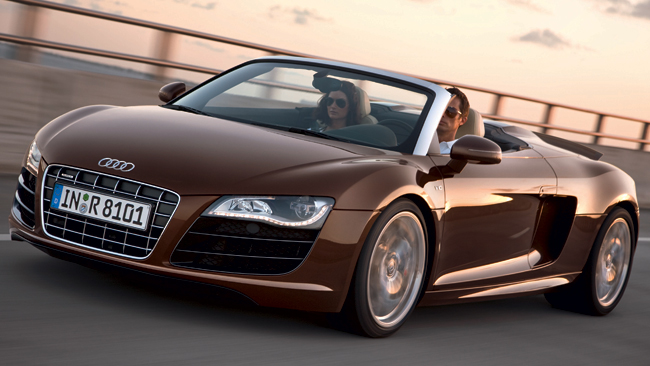It doesn’t have the ‘sideblades’ that are the unforgettable visual signature of the Coupe, but the R8 Spyder doesn’t have any trouble turning heads.Even in Antibes, on France’s wealthy Cote d’Azure, other drivers, motorcyclists, scooter riders and poodle-walking pedestrians stared and mostly smiled. Many asked questions. In French, of course, although one Honda rider I could understand. But his line of inquiry seemed a little … intimate. “You make business?” he shouted loudly. Twice. Erm…Green light. The Audi’s V10 – 5.2-litres of direct-injected, dry-sumped, free-revving and high-class kilowattage – drowned out whatever it was he said next. This is a glorious engine, but it’s also part of a drivetrain already familiar from the Coupe.Best not to waste too much time, then. Sounds wonderful, great power, nicely linear delivery, redlined at 8000rpm. Manual transmission good, optional R-tronic sequential not so good: can be caught in the wrong gear at low speeds in its ‘automatic normal’ mode; it’s much better at making you sound faster than you are in paddleshift ‘manual sport’ mode.And the rear-drive-biased quattro drivetrain and locking rear differential deliver reliable, magnetic traction.Most (70 percent) of the web of aluminium extrusions, vacuum-cast nodes and sheet metal that makes up the Spyder’s body structure is shared with the Coupe. Weight of the convertible’s bare body is only 6kg more, despite the reinforcements required to restore rigidity lost with the roof.Of the external panels, only the front guards, doors and bonnet are aluminium. The rest is thermoplastic, fibre-reinforced plastic or resin-transfer moulded carbonfibre. All up weight is 1720kg with the manual, and little more with the R-tronic.R8 Spyder’s claim to techno-fame? It’s the first car into production with seatbelt-mounted phone microphones. Three of them, so that there’s always a mike close to the driver’s mouth, regardless of their height.Though wonderfully well engineered, and a rewardingly sensual drive, the Spyder isn’t perfect. Taller drivers going topless may find their quiff ruffled by air spilling off the low header rail. Cargo space is negligible, only 100 litres. Ride comfort on the optional, Bilstein-damped sport suspension is fairly brusque. And the optional ceramic brakes are devilishly difficult to modulate smoothly in city driving.Best to forget the options, then. None of them buys you one more look than the standard car will pull.






